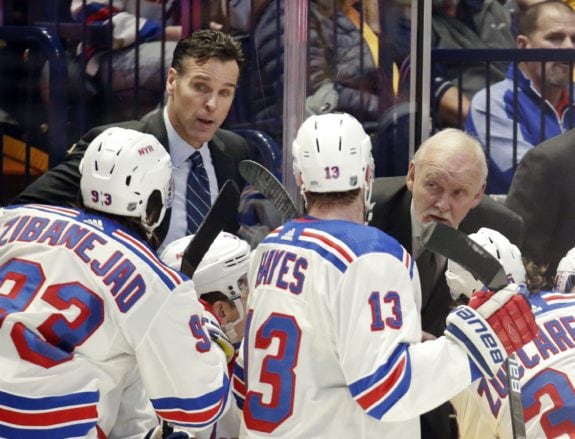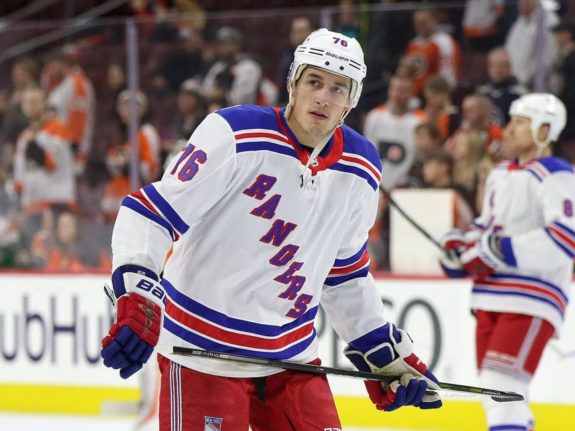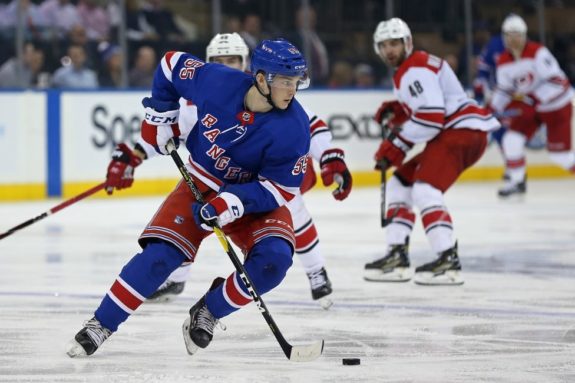The vast majority of the excitement over the New York Rangers’ rebuild has been focused up front to this point.
That would be on the forwards, a mostly raw but talented young group which offers cautious optimism that at least several future cornerstones could emerge in the coming seasons. The hope extends to a potential franchise forward sure to be taken by the Blueshirts with the second overall draft pick, likely Finnish star Kaapo Kakko, as well as the tantalizing possibility that the Rangers might be the front-runners to sign Columbus Blue Jackets sniper Artemi Panarin as a free agent July 1.
Head coach David Quinn and his staff turned in the kind of tough-love teaching season that was expected of him when he was hired, and his efforts started to show glimpses of progress toward the end of 2018-19.
With one notable exception, the development project centered mostly on the forward lines rather than defense last season in large part due to organizational makeup, with more spots and closer-to-NHL-ready prospects amongst the club’s forwards.

Next season should see Quinn working more intently on bringing up the next generation of Blueshirts blueliners. That process, however, is sure to go somewhat differently than it has for the efforts up front.
Because while the coach was able to easily insert young players into the forward lines and start the process of encouragement/benchings/returns to the lineup as they grew, the Rangers’ defense remains populated with three high-priced veterans whose presence will have to be accounted for, one way or the other.
Young Defense Prospects Knocking on the Door
There’s no shortage of up-and-comers set to vie for spots on the backline in the next few seasons within the organization. Two of those, Libor Hajek and Ryan Lindgren, showed promise in cameos last season and might be ready to fully enter Quinn’s “training program.”
The challenge for Quinn, who expertly handled almost every situation thrown at him in his first experience as an NHL head coach in 2018-19, will be what to do with Marc Staal, Kevin Shattenkirk and Brendan Smith – each of whom are locked up for two more seasons at veteran money – while he tries to push the rebuilding of the defense ahead to more closely align with that of the forwards.
Staal, on the books for $5.7 million through 2020-21, has been an effective force both as a defender and leader the past two seasons. Relegating him to a sporadic role, and thus diminishing his influence on the young blueliners, has the potential to be substantially counterproductive.
The Rangers have committed themselves (perhaps ill-advisedly) to 25-year-old Brady Skjei to the tune of six years at an annual cap hit of $5.25 million. If Staal and Skjei are going to play regularly, that leaves one spot open on the left side.

Hajek looked very good in five games before suffering a season-ending shoulder injury, exhibiting the excellent skating and puckhandling that made him the centerpiece of the Ryan McDonagh – J.T. Miller trade in February 2018. Lindgren, who the Rangers envision as a future leader, also showed flashes in a five-game audition.
Both youngsters are left-handed shots. Will there be room for both to get significant development time at the NHL level, or will they be locked in a season-long battle for one spot with Staal and Skjei ahead of them?
There is, of course, a good chance that this will work itself out – players get hurt, Hajek and/or Lindgren could prove unready – but the distinct possibility exists that both kids could be healthy and ready to play, creating a logjam.
Buyouts Could Create a Bigger Problem
The knee-jerk reaction to the problem is to buy out the contract of at least one of the three veterans this offseason. As previously written in this space, though, that could prove to be a big mistake. Along with extending already messy financial commitments to four years rather than two, which could hinder near-future efforts to sign free agents as the Rangers theoretically start to become competitive again, Staal, Shattenkirk and Smith can at least provide some veteran stability and cover for young players trying to establish themselves. The youthful mistakes of defensemen are of course magnified when compared to those of inexperienced forwards.
Assuming the front office chooses not to engage in buying out one or more of the veteran defense trio, Quinn’s next act – paired with continuing his development of the forwards, of course – will be of the balancing variety. He’ll be trying to get the older defensemen to help facilitate the process of younger players taking some of their ice time and eventually, their jobs.
In the case of Shattenkirk and Smith, they’ll have to play better for Quinn to worry about it. Shattenkirk seems the most likely candidate to be bought out – his fairytale signing with his hometown team on July 1, 2017, for four years has proved to be a major disappointment. With injuries and age robbing him of the burst and quickness that made him an irresistible signing, Shatty’s best daysappear to be behind him.

Shattenkirk could be saved by the fact that he plays the right side – an NHL-wide commodity which the Rangers don’t possess in spades. Also playing into Shattenkirk’s status is the case of Tony DeAngelo, the talented young right-side D-man to whom Quinn did devote major time to last season. Despite making big strides with his game in 2018-19, the 23-year-old continues to struggle with maturity issues and can hardly be counted on to continue his ascent.
Smith might also have moved out of the way of Hajek, Lindgren and some of the club’s other defense prospects somewhat by willingly and capably handling a move to occasional fourth-line forward duties last season. That versatility could prove key to the blueline rebuild, allowing Quinn to play the kids more should it be warranted while sliding Smith back to defense if additional veteran presence is required.
Quinn’s Task About to Get More Challenging
Even if a potential blueline clash between present and future can be alleviated to a degree in 2019-20, Quinn is sure to be dealing with this complex undertaking in some form over the next few seasons. He’ll also need to figure out what to do with 23-year-old Neal Pionk, the right-handed defender who exhibited exciting skating and puck skills last season but who wore down and might not have the size or defensive chops to be considered a future anchor on the backline.
Beyond Hajek, Lindgren, Pionk and the enigmatic DeAngelo, Yegor Rykov and 2018 first-round picksK’Andre Miller and Nils Lundkvist could be knocking on the door soon. The key for Quinn over the next couple of years will be to find enough minutes to conduct NHL-level “tryouts” for the kids, and simultaneously keep the veterans (if they’re around) sharp and engaged while accounting for their professional pride and experience.
Oh, and there’s also that whole Henrik Lundqvist succession plan to deal with …
The former Boston University coach knew he was taking on a challenge when he signed up for Broadway. The endeavor should only get more involved for Quinn in 2019-20 and beyond.